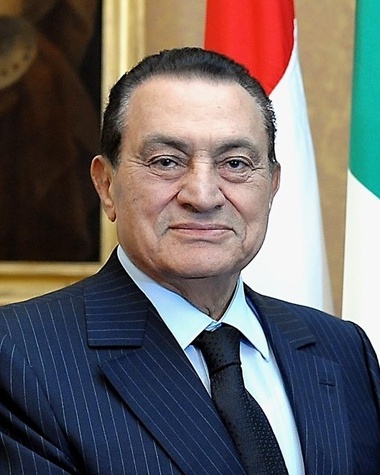
Mohammed Hosni Mubarak
Former President of Egypt

His Birth And Upbringing
Muhammad Hosni Mubarak was born on May 4, 1928 in Kafr Moselha to a father, Mr. Ibrahim Mubarak, and a family belonging to Sidi Mubarak, the owner of the well-known shrine at Zawyet al-Bahr in Buhaira Governorate, which many people visit to seek blessings from him. His father, Mr. Mubarak, used to work as an employee in the Tanta Court before The establishment of the Shebin El-Kom Court, and he died in the same year in which he was referred to retirement in 1960, and his mother is Mrs. Naima Ahmed Ibrahim, who died on November 22, 1978 when he was Vice President Sadat. The former president has four brothers and sisters, three males and one female, they are “Samia, Sami, Fawzi and Essam,” and the latter is the only one of the family who visited Alaa and Jamal in Tora, according to what was published in the newspapers. And the people of his village, Kafr Moselha, mention that his relationship with the village was severed when he joined the Military College, although his parents were residing there. Kafr Musailha came once every three months or more, and his mother was not mentioned in his news or visits.

Education
He completed his secondary education at Al-Masa’i Al-Mashkoura Secondary School in Shebin Al-Kom, then joined the Military College, obtained a Bachelor of Military Sciences in February 1949, and graduated with the rank of second lieutenant. An infantry officer joined the 2nd Mechanized Brigade for a period of 3 months, and the Aviation College announced the acceptance of a new batch of graduates from the Military College, so Hosni Mubarak applied to join the Air College, and passed the exams with eleven officers who were accepted by the college, and graduated from the Air College, where he obtained a degree Bachelor of Aviation Sciences from the Air College on March 12, 1950. In 1964, he received postgraduate studies at the Frunze Military Academy in the Soviet Union.
Jobs
He graduated in military jobs upon his graduation, where he was appointed to the Air Force in Arish, on March 13, 1950, then transferred to Helwan Airport in 1951 for fighter training, and continued until the beginning of 1953, then transferred to the College of Aviation to work as a teacher there, then an assistant to the College’s War Staff , then Staff of the College War, and commander of a squadron at the same time, until 1959. He was captured, accompanied by Egyptian officers, after their emergency landing in Morocco on board a helicopter during the Sand War that broke out between Morocco and Algeria.
He traveled on multiple missions to the Soviet Union, including a training mission on the Ilyushin-28 bomber, and a training mission on the T-U-16 bomber. He also received postgraduate studies at the Frunze Military Academy in the Soviet Union (1964-1965 AD). Muhammad Hosni Mubarak, Commander of the Bombers Brigade, became Acting Commander of West Cairo Air Base until June 30, 1966.
On June 5, 1967, Muhammad Hosni Mubarak was the commander of the Beni Suef Air Base. He was appointed Director of the Air College in November 1967 AD, and that period witnessed the War of Attrition. He was promoted to the rank of brigadier general on June 22, 1969, and held the position of Chief of Staff of the Air Force, then Commander of the Air Force in April 1972 AD, and in the same year he was appointed Deputy Minister of War.
He commanded the Egyptian Air Force during the October 1973 war, and Major General Muhammad Hosni Mubarak was promoted to the rank of Lieutenant General in February 1974. On April 15, 1975, Muhammad Anwar Sadat chose him as Vice President of the Republic, to hold this position (1975-1981 AD). And when Sadat announced the formation of the National Democratic Party, headed by him, in July 1978 AD, to be the government party in Egypt instead of the Egyptian Party, Hosni Mubarak was appointed as the deputy head of the party. At this stage, he undertook more than one Arab and international mission, and he made many visits to countries around the world, which contributed greatly to strengthening the relations of these countries with Egypt.
On October 14, 1981, Muhammad Hosni Mubarak assumed the presidency of the Arab Republic of Egypt, after a referendum was held on him after the People’s Assembly nominated him in a popular referendum, to succeed President Muhammad Anwar Sadat, who was assassinated on October 6, 1981 AD, during the military parade that was held on the occasion of the celebration of the anniversary of the October victories. 1973 AD. On January 26, 1982, he was elected president of the National Democratic Party.
His role in the October 1973 war
He led the Egyptian Air Force during the October War and was known as the owner of the first air strike, as it had a great impact in hitting the vital points of the Israeli forces in the Sinai, which upset its balance and allowed the Egyptian ground forces to cross the Suez Canal and control the eastern bank of the canal and several kilometers in the first days of the war under cover and protection. Egyptian Air Force.
Gulf War in 1991 AD
Egypt was a member of the Allied coalition during the 1991 Gulf War; The Egyptian infantry were among the first to land in Saudi Arabia to drive the Iraqi forces out of Kuwait.
Egypt’s participation in the war cemented its central role in the Arab world and brought financial benefits to the Egyptian government. Reports of up to $20 billion in debt forgiveness have been published in the media. According to The Economist:
The program worked like a charm: a book case, says [the International Monetary Fund]. Indeed, luck was on Hosni Mubarak’s side. When the United States was looking for a military alliance to force Iraq out of Kuwait, the Egyptian president joined without hesitation. After the war, his reward was that America, the Arab states of the Persian Gulf, and Europe gave up about 20 percent of Egypt
Presidency of Egypt
October 14, 1981 Muhammad Hosni Mubarak took over the presidency of the Arab Republic of Egypt, in a popular referendum after the People’s Assembly nominated him when Sophie Abu Talib, Speaker of the People’s Assembly at that time, was the interim president of Egypt after Sadat’s assassination.
On October 5, 1987, a referendum was repeated on him as President of the Republic for a second presidential term.
1993 A referendum was repeated on him as President of the Republic for a third presidential term.
On September 26, 1999, a referendum was repeated on him as President of the Republic for a fourth presidential term.
He was also elected for a new term in 2005 in the first multi-party presidential elections in Egypt, following a constitutional amendment in light of elections that witnessed violence and arrests of opposition candidates.
Mubarak stepped down from power on the night of February 11, 2011, and the Supreme Council of the Armed Forces was assigned to run the country’s affairs following the revolution of January 25, 2011.
Decisions He Made
In 1982, in the aftermath of the complete Israeli withdrawal from the Sinai on April 25, Israel claimed its right to the strategic Taba region, so he made a decision to resort to international arbitration, where he recruited a group of experts who were able to prove Egypt’s historical right to Taba for the International Court to rule on the return of Taba to Egypt, where he filed a lawsuit. The Egyptian flag on Taba on March 19, 1989, to complete the liberation of the entire national territory.
In September 2003: He canceled 14 articles in his capacity as the country’s military ruler.
Among the 21 articles of the emergency laws in force since the assassination of President Anwar Sadat. In September 2003 AD: He gave orders to the Egyptian Minister of Interior to draft a new law that would allow every Egyptian woman married to a foreigner to grant her children the Egyptian nationality. In December 2006 AD: He referred 40 leaders of the Muslim Brotherhood To a military trial in his capacity as the military ruler of the country, the decision that the Administrative Judicial Court of the State Council ruled on Tuesday, May 8, 2007 AD, headed by Counselor Muhammad Al-Husseini, Vice President of the State Council, a decision refusing to implement the decision of the President of the Republic, which was appealed by the President, so the Appeals Examination Court ruled to support the President’s decision.
January 28, 2011: In his capacity as the country’s military ruler, he decided to impose a curfew for the second time since the 1981 Emergency Law (the first time was during the events of the Central Security Forces in 1986).
January 29, 2011: Ahmed Shafiq was appointed prime minister and Omar Suleiman was assigned as Vice President of the Republic.
February 11, 2011: He decided to abandon the rule of the Arab Republic of Egypt and assigned the Supreme Council of the Armed Forces to run the country’s affairs.
25 January reveloution
On January 25, 2011, a wave of demonstrations began, culminating in Friday, January 28, when the number of participants was estimated at eight million people.
All over Egypt, and the Egyptian regime confronted these demonstrations with violence that led to the death of hundreds, especially in the city of Suez. Inside the cities, the army command announced that it would not attack the demonstrators. Mubarak delivered two speeches during the events. In the first, he announced a set of decisions he described as reforms. In the second, he said that he would not run for a new presidential term in the next elections, stressing that he would not step down. Immediately after that, demonstrations began. She chanted slogans in support of Mubarak and clashed with the sit-ins demanding the overthrow of Mubarak’s rule in several areas, the most important of which was Tahrir Square in the center of Cairo, in the absence of the army’s intervention.
By Friday, February 4, Mubarak’s supporters, who described the attackers as thugs, were no longer prominent, and it became clear that among them were members of the Mubarak regime’s security services, in addition to groups that “earned money” or mobilized against the demonstrators for the fall of Mubarak. Since the morning hours, an estimated hundreds of thousands gathered across Egypt in demonstrations for the fall of Mubarak, and prominent personalities joined them.
On February 10, 2011, his deputy, Omar Suleiman, was delegated in a statement he delivered to the people, but the statement was not received with any approval, and as a result, the demonstrations intensified and millions took to the streets, demanding his departure. The Supreme Council of the Egyptian Armed Forces. Millions of people poured into the streets of Cairo and the rest of the Arab cities to celebrate his passing, especially in Tahrir Square.
